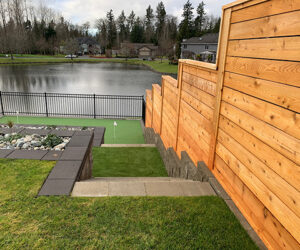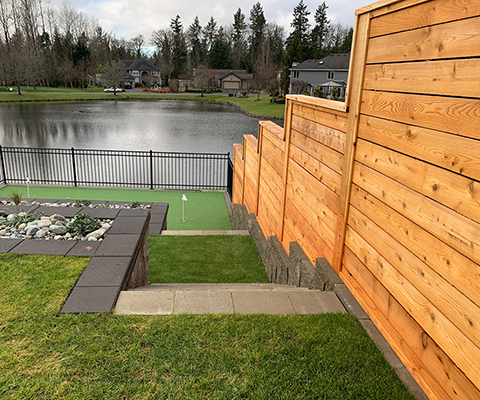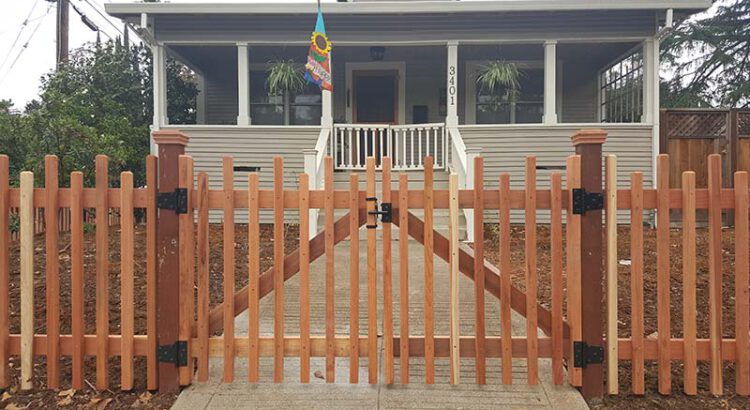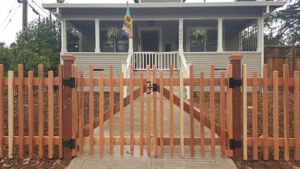Fences are installed for a variety of reasons, including to add privacy security and to define property boundaries. They come in a wide range of materials, styles, and costs.
Review your fence plans with neighbors, especially if you live on a shared lot. You should also get a land survey to ensure you are building on your property and not obstructing utility lines or rights of way.
A number of materials are needed to build a fence. Many are commonplace and are likely to be present in your tool shed or garage. A tape measure, marking spray paint, and string are essential tools that will help delineate a fencing line to give you an idea of where the posts and fence panels will be located. A post hole digger and digging bar are necessary for excavation, while a Phillips screw driver or cordless drill with the appropriate bit is required to fasten the fence components together.
A variety of wood fencing materials are available, including cedar and redwood. Both are highly durable and resist rot, but they do need to be treated with a preservative wood stain to prolong the life of your fence. Wood fences can also be stained or painted in a variety of colors to suit your style.
Vinyl fences are a popular and cost-effective choice that is resistant to fading, warping and cracking. These can be installed with or without posts and are often topped with decorative finials for an elegant look.
Aluminum fences are a lightweight option that is ideal for a variety of settings. They are strong, rust-resistant and easily cleaned with soap and water. They can be constructed on a flat or sloped ground and can be built to your desired height.
Wrought iron is a traditional option that can last for years with proper maintenance. This durable material can withstand a lot of abuse from the elements and is often capped with decorative finials to add to its elegance.
Before starting on a fencing project, check to make sure that you have all the proper materials and a permit, if needed. It’s always better to be prepared than to be caught off guard by a local building code requirement that you weren’t expecting. You will likely need to mark the locations of utility lines with wooden stakes and a string line, as well as have a survey done to ensure your fence is completely on your property. If you’re not sure about what your jurisdiction requires, it’s best to contact your town building inspector for information and preparation requirements.
Preparation
There is a lot of preparation needed to get ready for fence installation. This is especially important if you will be hiring a professional to complete the job for you. Taking the time to make sure that everything is set up correctly before the construction starts can save you a lot of stress and money in the long run.
The first thing you need to do is mark out the area of your yard that you plan to have the fence go up in. This will help to ensure that the crew does not accidentally dig into anything that could be a dangerous or costly mistake later on down the line. You should also walk the area and look for things like large rocks, tree stumps, weeds, or major slopes that may affect what type of materials you need to use.
If you have a garden, flower beds, or other types of fixed decorations in the areas where your fence is going to be placed, it is a good idea to relocate them somewhere else in the yard that will not be affected by the construction process. Doing this will also prevent them from being accidentally damaged or stolen by the crew during the installation.
It is also a good idea to speak with your neighbors before beginning the fence construction. This will ensure that they are on board with the style, length and color of your new fence. If they share a property line with you, it is even more important that they are aware of your plans. This will ensure that there are no conflicts or disputes in the future about your property lines or their yards.
You should also take the opportunity to do any staining or painting that you need to be done on your fence posts or panels before the fencing specialists arrive. Doing this early on in the project will give you a chance to let the stain dry completely before the crew begins working with it. This will make the finished product look better overall.
Installation
To ensure that your fence is safe and sturdy, it’s important to take accurate measurements before you start digging holes for the posts. A good rule of thumb is that the hole for each post should be at least as deep as the height of your fence plus one-third to one-half. This allows the posts to be properly supported after they are filled with concrete or other materials. You’ll also want to consider your soil type; sandy soils will require deeper holes than loamy soils.
First, determine your property line by talking to neighbors and checking a survey map. If you’re unsure of the boundary, hire a land surveyor to help you figure it out. The last thing you want is to build your fence on someone else’s land.
Once you’ve established the boundaries of your yard, mark where each corner and end fence post will go with wooden stakes. Then, stretch out a string line from each stake and mark the location of the line posts on it with the same pegs you used earlier. This will give you a straight line guide for where the rest of the fence posts will go.
Before you dig any holes for fence posts, check to see if there are any buried utility lines nearby. In most areas, this is required by law. Many states also have a “one call” system where you can place a phone call to have all buried utilities marked before you begin construction.
Depending on the type of fence you’re building, you may need to lay out additional lines for your chain link or aluminum fencing. These lines will need to be at equal distances from the corners and end posts, as well as the lines between each panel. You’ll also need to mark any locations for gate openings.
Before starting to install your fence, read the detailed installation instructions that came with your supplies. Then, make a list of the materials you need to complete the job. Be sure to include any tools you’ll need, such as a post-hole digger or power auger.
Maintenance
Fences are a crucial part of your property, providing security and privacy while adding aesthetic appeal. However, just like any other structure on your property, fences require maintenance to prolong their lifespan and keep them looking their best. Regular cleaning, inspections, coating maintenance, moisture prevention, pest prevention, and routine repairs are recommended for wood fences.
Creating a schedule to maintain your fence will help prolong its life and keep it looking good. Recommendations for the frequency of maintenance vary depending on the type of fence and the environment it’s in, but should include periodic cleanings and re-staining, and should address issues like soil grading, landscaping damage, and water exposure.
Start your maintenance by thoroughly cleaning the fence with a pressure washer or soap and water to remove any dirt, mildew, or other debris. Be careful when using a pressure washer on wooden fences, as excessive force can splinter the wood.
Examine the condition of the fence for loose boards and rusted or broken hardware. Replace any damaged components. If any boards appear swollen or warped, use waterproof glue to fix them. Be sure to countersink any protruding nails. Refasten any loose boards and use corrosion-resistant screws. Inspect the area around your fence for any drainage problems or soil grading issues that could cause moisture damage to the wood.
Wood fences should be re-stained every couple of years to keep them looking new. Use a preservative that’s appropriate for your location and weather conditions. If your fence is painted, re-paint it every few years to refresh the color.
Moisture prevention is critical for wood fences. Keep an eye out for signs of moisture damage, including water stains, rotted or warped boards, and insect infestation. Treat the wood with a termite-resistant product and take preventive measures to keep your property pest-free.
Inspect your fence for any signs of termite activity, such as small holes, sawdust, or termite tubes. Taking prompt action may save the rest of your fence from extensive damage and pest-related costs. You should also check for and address any pest-related structural damage, such as loose or sagging boards, rotting posts, and weak areas.


